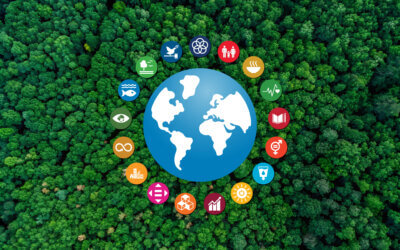As the world becomes more aware that carbon dioxide and other greenhouse gas (GHG) emissions have serious effects on our atmosphere and global climate, new methodologies are surfacing to achieve carbon mitigation and sequestration. One such method is using carbon credits, which work to funnel money toward sustainability projects that reduce the overall amount of carbon in the atmosphere.
Carbon credits provide individuals, businesses, and large organizations the opportunity to offset their greenhouse gas emissions. While much of the world still relies on fossil fuels for energy, carbon credits provide an excellent option to make a difference in the global fight against climate change.
Whether you are looking to reduce your carbon footprint or reduce your business’s carbon emissions, carbon offset credits are an excellent place to look. Today, we will cover what carbon credits do and how they work. We will look into what project types carbon credits support and how those projects can make a difference in the fight against global warming and climate change. Finally, we will cover how you can purchase carbon credits to become involved in the commitment to a green future.
What Are Carbon Credits?
A carbon credit is created when 1 metric ton of carbon dioxide is removed from, or prevented from entering, the atmosphere through an emission reduction program. Project developers can then sell carbon credits to fund current or future carbon offset projects.
The projects that create carbon credits are greenhouse gas reduction programs that work to achieve energy efficiency, develop renewable energy solutions, capture methane, and reduce waste. Any project that accomplishes these goals, and reduces the equivalent of 1 ton of carbon emissions, can begin creating and selling carbon credits.
How Do Carbon Credits Work?
Even if you make a significant effort toward carbon reduction, sometimes the use of carbon-emitting fuels is unavoidable. You might have to rely on air travel for work or to visit family, or you may need electricity generated by burning fossil fuels to power your home or business. There are many reasons why individuals and organizations are unable to go completely emission-free, and carbon credits provide a solution to this problem.
Carbon credits help individuals and organizations indirectly reduce their carbon footprint when they cannot directly reduce emissions on their own. This provides an excellent opportunity for individuals, small businesses, and large corporations to contribute to sustainability and outset global emissions.
One example of a large organization that utilizes carbon credits is the University of California education system, which aims to become carbon neutral by the year 2025. The higher-education institution successfully reduced their emissions by 15% from 2013 to 2020.
Most of their emissions came from the energy they used to heat and cool their campuses; energy that came from power plants that burn natural gas. To combat this, they began purchasing carbon credits that put money toward projects that reduce greenhouse gas emissions that are out of their control.
If the entire University of California education system can benefit from using carbon credits, so can individuals and small businesses. The money spent on carbon credits goes toward projects that benefit the entire globe. Even if you purchase carbon credits that support projects on the other side of the country, you are still participating in carbon projects that reduce emissions from an atmosphere we all share. Putting money toward climate action will benefit the whole globe.
How Do Carbon Credits Slow Climate Change?
While businesses, individuals, and nations worldwide need to do everything in their power to achieve a net-zero future, it is impossible to make the switch overnight. Much of the world still uses fossil fuels for its power generation, resulting in dirty, greenhouse-gas-emitting energy production. Much of the transportation sector still relies on petroleum products for power. Carbon credits present a solution that can slow the effects of these emissions on climate change today.
When carbon credits are purchased, the money goes toward projects that are tailored to reduce emission levels and sequester carbon from the atmosphere. The fewer greenhouse gas emissions that occur and the more carbon removed from the atmosphere, the more greenhouse gas effects will not happen as quickly, and global temperatures will not rise as fast.
Limiting global warming to below 1.5 degrees celsius (2.7 degrees Fahrenheit) compared to preindustrial temperatures is part of the Paris Agreement, and carbon offsetting helps us toward that goal.
What Is the Difference Between Voluntary and Mandatory Carbon Markets?
There are two types of carbon offsetting markets. There are voluntary markets in which individuals or business entities choose to participate in carbon offsetting independently. Then, there are mandatory markets, where large businesses are required by local law to purchase carbon credits and support projects that are involved in carbon dioxide emission reductions.
Anyone can participate in voluntary carbon markets. Say you are an individual planning a wedding and want to purchase carbon credits to offset the emissions that come with your big day; they are available to you. Maybe you own a business and want to reduce the overall emissions of your operation; you can find those as well. Voluntary carbon credits are a great way to participate in fighting against climate change today, and anyone can do it!
For the mandatory market, big businesses and organizations are sometimes required to purchase carbon offset credits because they are responsible for the largest emissions of greenhouse gases. While many nations mandate large corporations to reduce their emissions in other ways, buying carbon credits provides just another option to reduce carbon levels.
What Projects Do Carbon Credits Support?
As mentioned earlier, carbon credits are created when specific projects work to remove carbon from the atmosphere. These projects can range from developing clean energy projects to capturing methane from farms or landfills. Below are some excellent ways carbon credits reduce greenhouse gas quantities in the atmosphere.
Farm Power
Methane is the second most emitted greenhouse gas after carbon dioxide and is emitted from rearing livestock and storing manure. Instead of allowing the methane to escape into the atmosphere, a tool called an anaerobic digester is used to capture the methane from animal waste as it decomposes. Once the methane is captured, it can be burned to create electricity. When burned completely, it is destroyed and does not release harmful emissions.
Landfill Gas Capture
Another way to capture methane is at landfills. While methane is not emitted as much as carbon dioxide is, it is much more potent over time and can cause more damage to the environment. Capturing gas from landfills is a great way to reduce methane from entering the atmosphere, especially since landfills are the third-largest emitter of the gas in the U.S. Gas capture systems are set up at landfills and collect the released methane as the waste decomposes. The gas is then burned to create power.
Renewable Energy From Wind Power
Wind energy is a renewable energy source that provides a sustainable electricity generation option compared to burning fossil fuels for energy. Plus, projects that support wind energy do more than create clean and cost-effective energy. Wind farms create jobs and help develop local industry and economy.
Forest Management
Forest management can make the earth a healthier place to live. Forestry includes protecting existing forests and the reforestation of damaged forests through tree planting and clear-cutting for new growth.
Forests act as carbon sinks, or natural environments that store and sequester carbon dioxide, and deforestation inhibits this natural process. When forests are maintained and restored, more carbon will be removed from the atmosphere through a natural process.
What Are Carbon Credits Good For?
There are many opportunities to purchase carbon credits. Whether you are looking to buy carbon credits to offset your activities, your family’s, or your businesses, there is likely a carbon offset program for you. Below are some areas of life for which you could purchase carbon credits.
Flight Carbon Offset
Individuals and businesses can benefit from flight carbon offsets. Per 1,000 miles of air travel, 500 pounds of carbon are emitted per passenger. As a whole, global air travel was responsible for 2.5% of global carbon dioxide emissions in 2018; that’s 1.04 billion tons of carbon dioxide.
Unfortunately, we do not yet possess the technology to clean up the aviation industry. Luckily though, flight carbon offsets present a great option to channel money into programs that can offset the amount of carbon emitted by global aviation.
Green Wedding Carbon Offset
Weddings can come at a carbon cost, but that doesn’t mean you have to hold back on your big day. From the carbon emitted due to travel on the way to the wedding to the food products and electricity used during the whole event, the carbon footprint of a marriage can add up. Look for green wedding carbon offsets to reduce the environmental impact of your wedding.
Day-to-Day Carbon Emission Offsets
You don’t have to go on a big trip or own a huge corporation to justify purchasing carbon credits. Whether you are paying to power your home or your local business, carbon offsets can help you stay green in your daily activities.
Driving, electricity, gas used for cooking, and much more are responsible for emitting carbon. For many of us, these activities are unavoidable, but we can still play a part by signing up for a monthly carbon offsetting subscription that can keep your day-to-day living green.
How Do You Buy Carbon Credits?
Anyone can buy carbon credits that are offered through companies that support clean energy and carbon sequestration projects. These companies will sell you carbon credits that can help you reduce your carbon footprint.
At Terrapass, we sell carbon offset credits for individuals, small businesses, medium-large businesses, and aviation companies. We also sell both Green-e Energy Certified RECs and Green-e Climate Certified Carbon Offsets for the voluntary carbon market. Purchasing carbon credits is the best way to get involved in the green future today.
Carbon Credits Can Help You Go Green Today
With one carbon credit representing the equivalent of removing 1 ton of carbon dioxide from the atmosphere, you can take a big step in participating in global sustainability. Knowing that your purchase goes toward projects that support reducing greenhouse gas emissions and carbon levels in the atmosphere is comforting as we face a changing climate.
If you are set on participating in carbon offsetting through purchasing carbon credits but don’t know where to begin, a great first step you can take today is calculating your personal carbon footprint. Then, visit Terrapass to learn more about all our carbon credit programs.
Brought to you by terrapass.com
Featured image:











